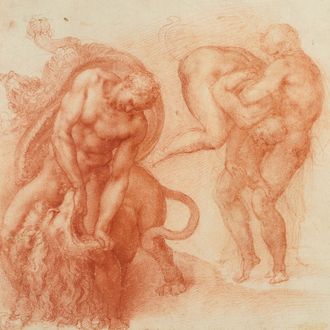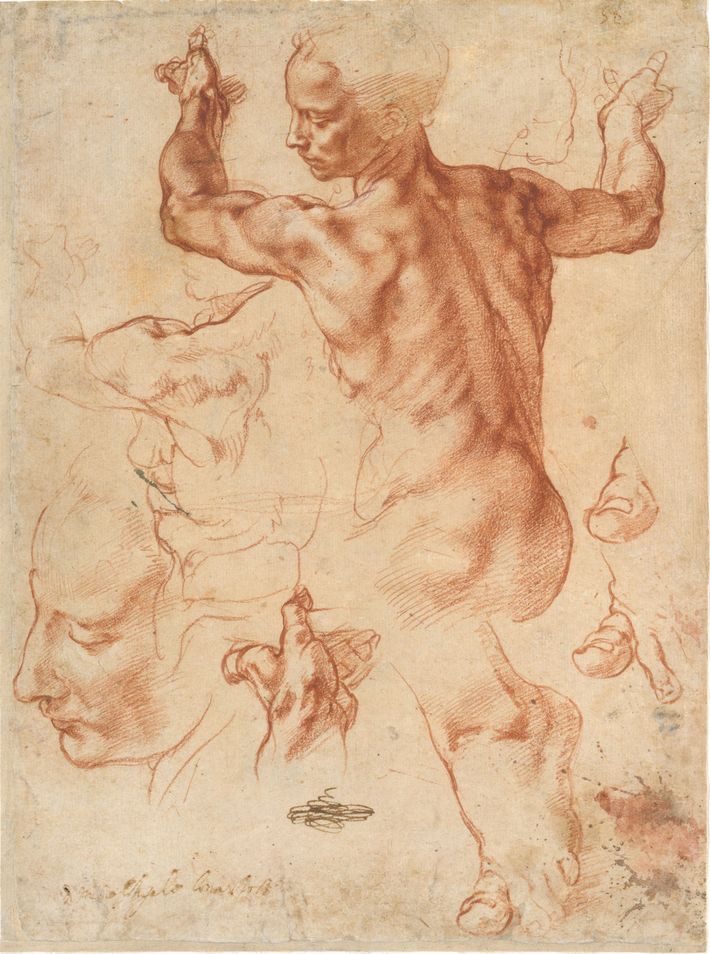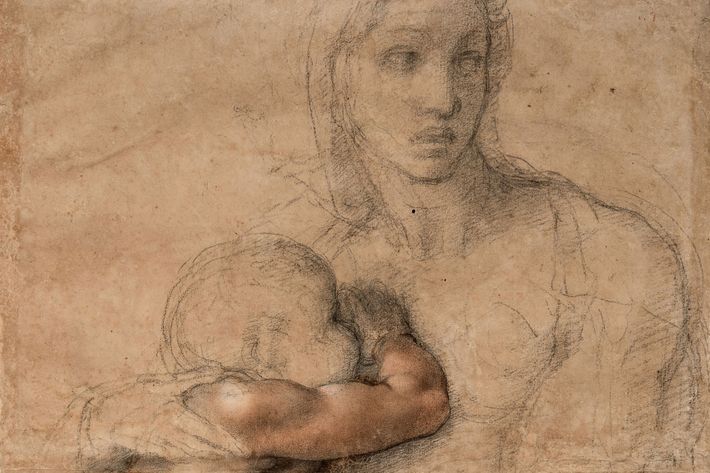
The Metropolitan Museum’s “Michelangelo: Divine Draftsman and Designer” is a stupendous metaphysical-visual exhalation. Somewhere amid the High Renaissance master’s drawings, time and mediums piled up for me, and art’s house was set on fire. The show burns, from Michelangelo’s time, into the past — with his rediscoveries and reinterpretations of Classical Greek and Roman art. It also simultaneously convulses forward, into sensibilities then unknown — breaching the exaggerations of Mannerism and the cinematic Baroque, into the cauldrons of brooding Romanticism, part-by-part Impressionism even into the shadows of our own existentialism. The tightly constructed survey, organized by the Met’s Dr. Carmen C. Bambach in 14 chronological galleries, is an exhibition in turns exhausting and exhilarating.
It is esoteric in its relentless focus on drawing, and you really have to get up close to these works to wholly imbibe them — which will be difficult given crowds; also Michelangelo’s are not works on paper that we love or covet like those of Seurat, van Gogh, Goya, Hiroshige, Wang Hui, Bill Traylor, or Rembrandt; Michelangelo leaves us thunderstruck, his work almost alien. But anyone willing to look, then go back through the show and look again, picking out, say, just eight favorite drawings will glean new physiognomies and hymns to the human body, the male one especially, and the aggrandizement, diminishment, dignity, and abjection of what it means to be born into the flesh. And all via drawing!
If Michelangelo’s 133 drawings, three marble sculptures, architectural models, and much other relevant supporting material is too much to take in, then just proceed to the midsection of the show to a gallery appropriately titled “The Sistine Ceiling.” There, stop, look up, gasp or laugh, then silently thank the Met for including a dazzling, perfect one-quarter reproduction of Michelangelo’s Sistine Chapel ceiling — hung on the ceiling and lit from behind. Please, table your thoughts of this being cheesy or chintzy. Just look around, since you are surrounded here by actual drawings done for these very figures you get a window into the ways this artist didn’t just make a drawing and reproduce it on the ceiling via painting. Instead, you can glimpse a mind on fire — ever changing, rarely focusing on faces, using every work he ever looked at or made before this, using his hand as a photographic memory forever thinking about how thighs torque, fingers plait, backs twist, torsos turn. It’s an anatomy lesson of things that do and don’t exist. In fresco Michelangelo might cover an area the size of a living-room wall in a day. Those drawings were all in his head by then and fed all his moves. You can get the chills at how wild this artist’s imagination really is, how revolutionary and weird. And be reminded that, however neatly you ingested art history in high school, probably every icon on that timeline is there because he or she (though, unfortunately, almost always he until recently) completely destroyed what was understood to be even possible before that. Perhaps none more than Michelangelo: Just consider, for instance, the ways that he sneaks in humongous giantesses into this Christian scenario, or the way that Michelangelo’s acrid floral coloring in this massive painting changes art history, filtering down to us not only through the genius of Pontormo, Parmigianino, and Bronzino, but from Ensor to the Expressionists all the way to artists like Lisa Yuskavage and John Currin — and is thousands of thankful miles from all of Leonardo’s brown.

How to get a handle on such an outsize artist and show? Other than saying that he makes the best hands in art history and that his art is at once brutal, spooky, muscle-y, riddled with different perspectives, and filled with doubt and hubris, my advice is keep it simple and really just follow your eye. The only real background you need to know is that Michelangelo was born outside Florence in 1475 and lived between there and Rome until he was 88. Famous from the start, he worked his whole life for successive popes, many of the Medici and other super-nobles with lots of money. The other artists around were the already famous Leonardo, 23 years his elder; Titian and Raphael, 13 and 8 years his younger, respectively. They don’t call this the High Renaissance for nothing. He was competitive too. On leaving Titian’s studio in Venice, Michelangelo reportedly said to Giorgio Vasari that “it was a pity artisans in Venice did not learn to draw well.” But that’s also how central drawing was to him and his notions of what was possible.
All these artists were taking from antique sculpture and classicism, moving the world well beyond the gothic, creating an ideal but naturalized art with real spaces, faces, figures, and subjects. All were prodigies. Michelangelo just upped the ante sooner. By 24, he’d sculpted the huge, silky, milky-finished marble Pietà that is now placed in St. Peter’s — a gigantic Mary supporting her even bigger dead son, his head thrown back, almost not visible; she, young, beautiful, enveloped in fabric; he, with wounds already healing, not bloody, beaten and tortured on the cross. The medieval and northern God who dies a violent death is replaced by an implacable physicality and an almost barge-like body. Both figures are filled with inhuman depths of pathos. By the time he was 26, he had made maybe the most famous sculpture in the Western world, David. This impassive ambrosial watchman, larger than any marble sculpture made since antiquity, is thinking, is more beautiful than anyone who ever lived — he’s just 17 if you know what I mean — simultaneously an incessant god, immensely distant, but also all of us as shepherds, inner saints, all looking for a more intense love. It is a shot of optical opium, moral philosophy, sensuousness, seriousness, and oceanic emotion.
Had he died after only these two works he’d still be among the greatest artists who ever lived and one of the best revivers of the Classical. But in 1506 something even bigger happened to Michelangelo — something any creative person who’s had an aesthetic conversion experience where everything changes will recognize. On January 14, 1506, in a vineyard on the outskirts of Rome, a farmer unearthed what turned out to be one of the most famous Hellenistic sculptures of the ancient world — one that was mentioned by Pliny, sculpted by Agesander, Polydorus, and Athenodoros (yes, artists had names back then and signed their work). This is the Laocoön and His Sons, a brutal first-century B.C.E. pulsating, writhing marble grouping of three figures with an enormous coiling snake encircling them, biting the side of the largest among them. (Laocoön is the Trojan who famously warned his people of “Greeks bearing gifts” and who Virgil tells us was punished by one of the gods favoring the Greeks who sent a snake to instantly kill Laocoön and his sons for it.) The pope sent Michelangelo to the pit as it was being dug out.
I think Michelangelo had a walking nervous breakdown. He dropped all commissions and left Rome for Florence shortly thereafter. The pope was furious with him and demanded, to no immediate avail, that he return to Rome. From this time on he destroyed hundreds, maybe thousands, of his drawings, and not a few sculptures, leaving many more unfinished, so we only have a tiny sliver of his drawings. He worked until just days before he died on one last Pietà — a sculpture of the dead Christ being supported the Virgin — so blurred it’s like a ghost dance of form. Whatever happened, everything changed in his art thereafter. Classicism was no longer perfect, proportioned, measured, magnificent physiognomies. It was alive, writhing, elastic, audacious, imperfect.
This is what is amazingly laid out in this show. We’re not getting the Michelangelo of perfection or the titan of the Sistine Chapel ceiling and The Last Judgment. Rather, we’re seeing an artist stop and start, reconciling deep inner urges, his own probably thwarted homosexuality, surging religiosity, and pride all mixed with a classicism now filled with elemental unconscious, id, asymmetry, and imbalance. Nothing like it had existed on Earth before.
Not just his vision but even his process was radical. Rather than beautifully blocking out well-proportioned sinewy saints and portentous church fathers, Michelangelo seems to start all his work from the center out. From a figure’s buff six-pack which he then works over and over before turning to a thrusting hip and twisting trunk turning in on itself, all while expressing inner drives, bodily knowing, electric sparks of consciousness, and moments of self-recognition. If he has to elongate a body to get to the emotion he wants, he does it. And the eye somehow makes these abstract shapes work. All these figures are modern consciousness in otherworldly astronomer bodies.
Note that most of Michelangelo’s faces aren’t that great — many are somehow cartoonish, mannered, weird, surprised. Instead he wants to make bodies talk. See ganglia of line transform into a body as imperator of extreme expression. Or observe the cadences of sorrow, joy, and divinity echo in how one arm supports another, an elbow props up a whole figure, backs turn in more than one motion at a time. Serpentine curves and flexed legs, a wrist twisted lifting a child, and necks that go up and up. Don’t try to unpack the subject matter of this work; just witness form, structure, the constructing of rhyming motions, rhythms of inner orbits spiraling outward. Do this, and after this show, you’ll be able to identify a Michelangelo drawing.

In a highly unusual move for a big show like this Bambach includes two galleries devoted to Michelangelo’s architecture. These are God sent. Here is an artist who didn’t even consider himself an architect, who’d never built anything, becoming one of the greatest architects who ever lived in real time in these drawings expanding ideas as radically dynamic as those in his sculpture and painting. No wonder his nickname is “Il Divino.” Even in this most concrete art where plans and proportions are required in order to build at all, Michelangelo was forever exploding space, opening up ceilings, expanding windows, adding a story here, shifting staircases, sandwiching niches where he would, and detailing every ceiling coffer. He must have made his clients batty. This is why we have so few finished architectural spaces by this artist. (Although the tremendous dome of St. Peter’s is his design.) Just follow the evolution of his designs for his tomb and sculptural “decorations” for Pope Julius II and you’ll see almost every subsequent type of architecture come into being and then collapse again.
But if I had to send you to just one section of the show, I’d suggest the extended galleries just before and after that Sistine ceiling space.
Here, a dozen or so works on their own might serve you well when you, too, one day stand at the gates of creative hell, naked and alone, confronting your own internal Laocoön moment. These two galleries run the gamut of his sensibilities. There is a beautifully finished drawing of an unearthly, handsome male youth rendered in shades so nuanced that they’re more auroras than marks. There are two portraits of Cleopatra, each with Black features, one with a snake that wraps itself around and bites her breasts. A head wears a fantastical helmet worthy of Dalí or Cecil B. DeMille. There are torsos done with true sculptural force and psychological intensity that blend from body to body and then into space so that you don’t really know what you’re looking at.
There’s a Virgin and Child where we see that same widening-gyre construction reiterated with infinite love. Here, Mary supports the baby Jesus with her left forearm, her hand reaching between his legs to cradle his hip as he wraps his arms around her neck and points to his first cousin St. John the Baptist. Nearby another Virgin with at least ten extra lower vertebrae and a forearm as long as a man’s thigh nurses a child. And then, witness the birth of all of William Blake in the exquisite Risen Christ, a figure stepping out of a tomb rendered so delicately that you might spend your whole time here looking for or trying to name what sort of touch this is. This is his David being reborn.
And there is so much more. I haven’t even mentioned the late drawings of Christ on the cross in the last galleries, the otherness and every kind of contrapuntal pose, the masterpieces of almost-abstraction, dramatic diagonals employed in faces, the physiological and psychic agonies in figures so unfinished and kindled with spirit that it’s like Michelangelo saw the elements that make us mortal. Just go.
*A version of this article appears in the November 13, 2017, issue of New York Magazine.




